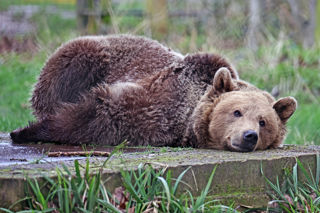
It’s torpor time for Wildwood’s brown bears
14th Nov 2025
Almost all brown bears in this area of the world enter a winter resting period sometime between October and December, which in very cold climates can last up to six months. It’s a long sleep called torpor - a healthy bear behaviour that our bears are showing as the British winter approaches.

What is torpor?
Torpor is a semi-hibernation in which bears conserve energy during a time of scarce food. In the wild, they cushion a den or a cave with grass, leaves, ferns, moss and lichen. Brown bears aren’t true hibernators like hedgehogs. Although their bodily functions slow, they’re easily woken and can defend themselves from attack. It can take up to an hour to wake an animal from hibernation, but bears can wake almost instantly from torpor.
Before their winter rest, bears need to eat enough to build up their fat reserves, as they lose around a third of their body weight during the sleeping phase and continue to lose weight in the first months after they awake. This is called hyperphagia: a period of intense feeding in autumn, including fruits, berries and insects, when they can eat up to 7,000 calories a day and put on 60kg of fat! As torpor approaches, bears switch their diet to grass and other vegetation to aid digestion.

What happens when they enter torpor?
When they enter torpor, the bears’ bodily functions slow down, yet their muscles don’t atrophy, they don’t get bedsores and their kidneys still function. This biological ability still isn’t fully understood.
During their sleep, they may wake occasionally to eat some grass or have a drink. They might sleep 23 hours 55 minutes and get up for five minutes or sleep solidly for four weeks flat. Just as each winter is different, no two bears behave exactly the same way. This flexibility in nature is vital to the survival of animal species in changing environmental conditions.
Torpor at Wildwood Kent
Our aim is to give our bears the most natural life possible, and a chance to express natural behaviours. Creating the conditions for torpor is therefore vital.
For wildlife parks and zoos, mirroring the conditions of torpor is still a relatively new practice, so we use trial and error to see what works best, and share our experience.

We build Fluff and Scruff one of the biggest, if not the biggest bear bed in Europe: a huge bed in their den that keeps them warm and the wind away. From one month before their anticipated torpor, all three bears are fed mainly grass, supplemented with leafy greens, mirroring what a bear would eat in the wild.
Enabling torpor is the best thing we’ve done for their health and behaviours. After their tragic start in life, Fluff and Scruff’s first ever torpor happened here at Wildwood and was for eight weeks. Scruff stirred but Fluff slept the eight weeks solid. In winter 2023/24, they slept for 14 weeks, and last year, for even longer. This year they’ve gone into torpor earlier, at the beginning rather than end of October. This is very positive, as we see health benefits every time they emerge from their winter sleep. Right now is the healthiest these bears have ever been, and given the good condition they’re in, we think they probably won’t extend their torpor much more.

As for young Boki, proper torpor begins around three to four years old, and he’s now three. Last winter, he surprised us by going into torpor - for 14 weeks - but this may have been due to exhaustion from his condition or operation for hydrocephalus. So this year is going to be educational for our keepers. Boki has a separate den with his own big bed for his winter sleep.
With scientific understanding still quite limited, Wildwood aims to lead the way in learning about bears and torpor. We don’t know what actually triggers torpor. Scientists used to think it was the cold. A more recent theory is daylight shortening, but this and last year Fluff and Scruff went to sleep well before daylight shortened. Nearly every brown bear keeper in the UK is seeing the same patterns, including going into torpor earlier.
Although you won't get to see them outside during winter, you may be lucky enough to see our bears on the big screen CCTV filming their den. It’s located on the footpath by the bear enclosure.
